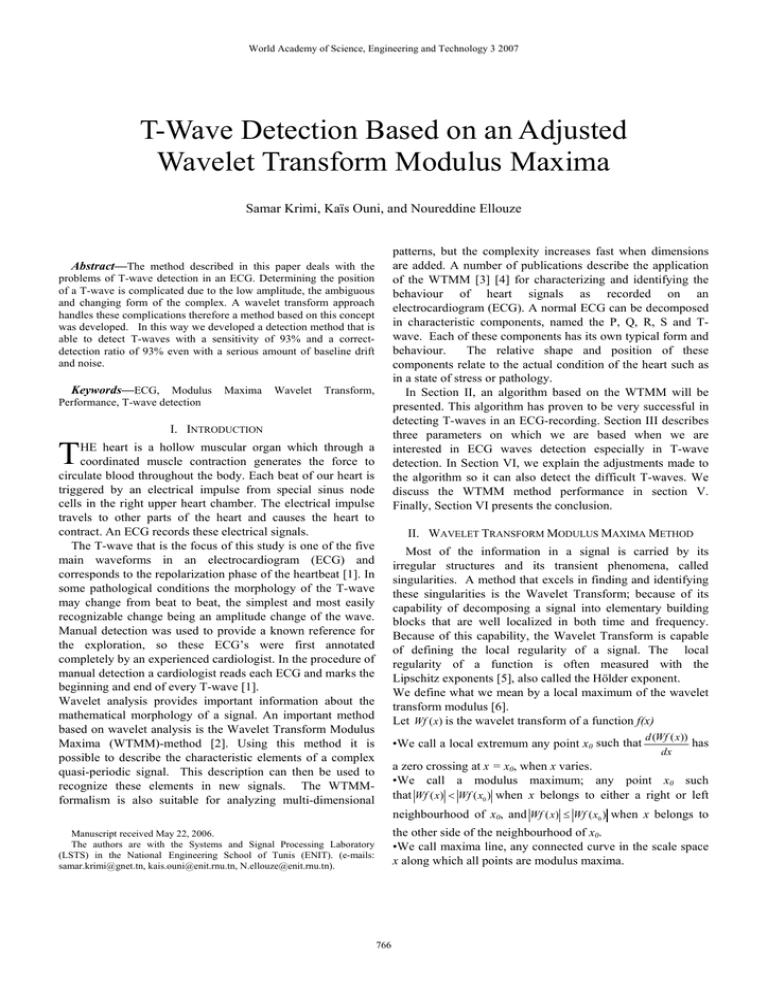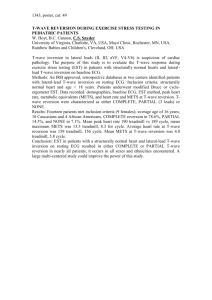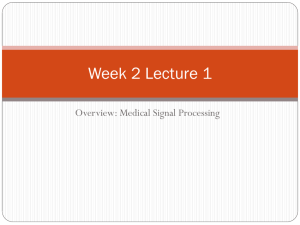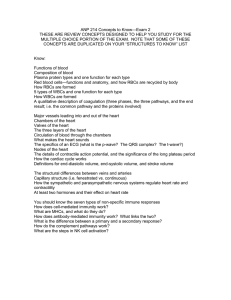as a PDF
advertisement

World Academy of Science, Engineering and Technology 3 2007
T-Wave Detection Based on an Adjusted
Wavelet Transform Modulus Maxima
Samar Krimi, Kaïs Ouni, and Noureddine Ellouze
patterns, but the complexity increases fast when dimensions
are added. A number of publications describe the application
of the WTMM [3] [4] for characterizing and identifying the
behaviour of heart signals as recorded on an
electrocardiogram (ECG). A normal ECG can be decomposed
in characteristic components, named the P, Q, R, S and Twave. Each of these components has its own typical form and
behaviour.
The relative shape and position of these
components relate to the actual condition of the heart such as
in a state of stress or pathology.
In Section II, an algorithm based on the WTMM will be
presented. This algorithm has proven to be very successful in
detecting T-waves in an ECG-recording. Section III describes
three parameters on which we are based when we are
interested in ECG waves detection especially in T-wave
detection. In Section VI, we explain the adjustments made to
the algorithm so it can also detect the difficult T-waves. We
discuss the WTMM method performance in section V.
Finally, Section VI presents the conclusion.
Abstract—The method described in this paper deals with the
problems of T-wave detection in an ECG. Determining the position
of a T-wave is complicated due to the low amplitude, the ambiguous
and changing form of the complex. A wavelet transform approach
handles these complications therefore a method based on this concept
was developed. In this way we developed a detection method that is
able to detect T-waves with a sensitivity of 93% and a correctdetection ratio of 93% even with a serious amount of baseline drift
and noise.
Keywords—ECG, Modulus
Performance, T-wave detection
T
Maxima
Wavelet
Transform,
I. INTRODUCTION
HE heart is a hollow muscular organ which through a
coordinated muscle contraction generates the force to
circulate blood throughout the body. Each beat of our heart is
triggered by an electrical impulse from special sinus node
cells in the right upper heart chamber. The electrical impulse
travels to other parts of the heart and causes the heart to
contract. An ECG records these electrical signals.
The T-wave that is the focus of this study is one of the five
main waveforms in an electrocardiogram (ECG) and
corresponds to the repolarization phase of the heartbeat [1]. In
some pathological conditions the morphology of the T-wave
may change from beat to beat, the simplest and most easily
recognizable change being an amplitude change of the wave.
Manual detection was used to provide a known reference for
the exploration, so these ECG’s were first annotated
completely by an experienced cardiologist. In the procedure of
manual detection a cardiologist reads each ECG and marks the
beginning and end of every T-wave [1].
Wavelet analysis provides important information about the
mathematical morphology of a signal. An important method
based on wavelet analysis is the Wavelet Transform Modulus
Maxima (WTMM)-method [2]. Using this method it is
possible to describe the characteristic elements of a complex
quasi-periodic signal. This description can then be used to
recognize these elements in new signals. The WTMMformalism is also suitable for analyzing multi-dimensional
a zero crossing at x = x0, when x varies.
•We call a modulus maximum; any point x0 such
that Wf ( x) < Wf ( x0 ) when x belongs to either a right or left
Manuscript received May 22, 2006.
The authors are with the Systems and Signal Processing Laboratory
(LSTS) in the National Engineering School of Tunis (ENIT). (e-mails:
samar.krimi@gnet.tn, kais.ouni@enit.rnu.tn, N.ellouze@enit.rnu.tn).
the other side of the neighbourhood of x0.
•We call maxima line, any connected curve in the scale space
x along which all points are modulus maxima.
II. WAVELET TRANSFORM MODULUS MAXIMA METHOD
Most of the information in a signal is carried by its
irregular structures and its transient phenomena, called
singularities. A method that excels in finding and identifying
these singularities is the Wavelet Transform; because of its
capability of decomposing a signal into elementary building
blocks that are well localized in both time and frequency.
Because of this capability, the Wavelet Transform is capable
of defining the local regularity of a signal. The local
regularity of a function is often measured with the
Lipschitz exponents [5], also called the Hölder exponent.
We define what we mean by a local maximum of the wavelet
transform modulus [6].
Let Wf ( x) is the wavelet transform of a function f(x)
•We call a local extremum any point x0 such that
d (Wf ( x))
has
dx
neighbourhood of x0, and Wf ( x) ≤ Wf ( x0 ) when x belongs to
766
World Academy of Science, Engineering and Technology 3 2007
When looking at a wavelet transform of a PQRST-complex
at higher scales it is obvious that the effect of the QRScomplex has not sufficiently faded in the environment of the
T-wave onset. This makes searching for characteristic points
concerning the onset very hard. Using low scale transforms
does not really improve the reliability, as the amplitude of the
onset is not sufficiently larger than the amplitude of frequently
appearing noise.
The problem with the QRS-complex does not concern the
offset and therefore it is detectable with a good reliability
when there is not a high amount of noise. The onset/offset are
normally characterised by a modulus maximum that occurs
before/after the T-wave that exceeds a certain threshold.
III. T-WAVE DETECTION
The T-wave which corresponds to the ventricular
repolarization of the heart has a remarkable behaviour in some
situations. This makes this phenomenon hard to detect. The
figure bellow illustrates some typical behaviour.
The first situation is a typical T-wave. The wave displayed
here has a rather large amplitude, so it will not be hard
to detect, however this amplitude can decline to very
small magnitude. In this case the standard methods will
have a very hard time pointing out the exact location of
the T-wave. The second situation has the same problems as
the first but here the T-wave has inverted itself. This makes
detection hard for some methods that do not use the modulus
of the signal. In the third situation, we present an ascending
or descending T- wave. Another problem that can occur with
all these situations is a bad positioning of the T-wave.
Sometimes it is situated to the close to the QRS-complex
or the P-wave. This makes it difficult to separate these two
complexes.
(a) positive T-wave
C. Choice of scales
The use of non-dyadic scales can be useful for detecting
low amplitude complexes. In this paper we use scale 10 for Twave detection. This scale appeared to give better results that
23 or 24. This choice was made because 23was too sensitive to
noise. 24 on the other hand, did not divide the complexes in
the transformation and therefore restricts good detection.
(b) negative T-wave
IV. ADJUSTMENTS OF THE WTMM FOR T-WAVE DETECTION
(c) ascending T-wave
The method described in the previous section and in the
article by Li et al. [3] is also suitable for detecting T-waves
after making some adjustments.
A normal T-wave and its transform clearly display a modulus
maxima pair with opposite signs. The T-wave is found at the
zero-crossing between the two modulus maxima.
Figure 3 shows an alternative T-waves, it indicates that not
all T-waves can be detected by searching for a modulus
maxima pair. In some cases, there is an only one modulus
maximum available. By using the method described below, it
is possible to detect most T-wave variations.
Although this method has a lot in common with the
standard WTMM method, the modifications will be described
step by step:
(d) biphasic T-wave
Fig. 1 various T-waves
Choice of scale 10
A. Choice and implementation of the mother wavelet:
The mother wavelet used in this study is the first derivative
of the Gaussian function. Other possibilities, like the second
derivative (Mexican Hat) were examined but did not offer any
advantages. In most studies concerning ECG detection [3][4],
the wavelet transform is implemented using a composition of
a low pass and a high pass filter.
This study however, used an implementation based on the
continuous wavelet transform of a discrete-time signal, as
discussed in the article of Provaznik [7].
Modulus maxima larger than
a threshold λT
The location &
Character of the T-wave
Fig. 2 Adjustments made for T-wave detection
B. Onset/Offset detection:
The T-wave is hard to detect in some cases because of its
low amplitude and its changeable state. By using the WTMM,
it is possible to detect certain characteristic points in the
wavelet transform. These points can then be used to develop
decision rules that help detect the T-wave. Applying this
method to detect onsets gives certain problems. The biggest
problem is the influence of the QRS-complex.
The T-wave’s energy is mainly preserved between the
scales 23 and 24. Therefore it was more appropriate to turn
away from the dyadic scales and to choose the scale 10 for the
WT. The next step consists of the search for modulus maxima.
At scale 10 we analyzer a signal and search for modulus
maxima larger than a threshold λT .
767
World Academy of Science, Engineering and Technology 3 2007
3) Baseline drift: The WTMM-based method only considers
variations of the signal that has a certain resemblance
with the T-wave. Therefore, it is insensitive to baseline
drift.
This threshold is determined by using the root mean square
(RMS) of the signal between two R-peaks. J.P Martinez [4]
found that λT = 0.25 RMS is suitable for detecting most of the
T-peaks. When there are two or more modulus maxima with
the same sign, the largest one is selected. After finding one or
more modulus maxima, it is possible to determine the location
and character of the T-wave. The first situation occurs when
there is a modulus maxima pair with opposite signs. This
indicates a small hill when the signs are +/- and a small
inverted hill when the signs are -/+. When there is only one
modulus maxima present, the + sign indicates a T-wave that
consists only in a ascending. When the sign is -, we see a Twave formed by an descending.
1150
1100
1000
800
------
------
Amplitude(µv)
1300
<----T
100
<----T
1.5
2
2.5
Time (s)
<----T
------
------
------
-----<----T
<----T
------
1
3
3.5
4
4.5
1500
1400
------
0.5
4) Ambiguous waves: As most standard methods, the
WTMM-based method uses certain decision rules to
distinguish different kinds of T-waves. The difference
with the other methods lies in the fact that the rules are
applied to the transformation instead of to the pure signal.
The transformation gives a clearer view of the signals
information and therefore it is better suited for decision
rules.
200
------
0
Fig. 5 Baseline drift (121.dat)
We will discuss certain parts of signals chosen from MITBIH Arrhythmia Database that will regularly lead to failure of
a correct detection due to frequently appearing difficulties in
T-wave detection.
1) Low amplitude: Most methods require frequently adapted
thresholds in order to detect a low amplitude T-wave. In
most cases these thresholds are used to distinguish the
wave from the noise. Figure 3 shows the capability of the
WTMM based method. By using scales that contain most
part of the energy of the T-wave it is possible to acquire a
precise detection.
1200
1100
0.8
-400
0
0.5
1
1.5
2
1
------
------
<----T
900
-300
<----T
1000
-200
------
-100
------
Amplitude(µv)
<----T
850
------
900
V. THE WTMM METHOD PERFORMANCE
0
------
950
------
Amplitude(µv)
1050
1.2
1.4
1.6
1.8
Time (s)
2
2.2
2.4
Fig. 6 Ambiguous waves (214.dat)
2.5
Time (s)
Fig. 3 Low amplitude (220.dat)
The datasets are signals coming from the MIT-BIH
Arrhythmia Database [8]. However not every long signal
contains large amounts of useful information. When there is
no change in a wave through-out the whole signal, it is not
useful to analyse every peak. Therefore, only the parts which
define the ECG will be discussed. The performance of the
methods will be tested by using several cases with certain
difficulties. Every case will be described first; next the
performance will be measured by certain parameters:
2) Noise: The WTMM approach used in this paper uses the
Gaussian wavelet as mother wavelet. A large advantage
of this choice is the “smoothing” property this wavelet
offers. The higher the scale, the smoother the
transformation. This results in a method that is very
robust to noise.
1200
• Number of True Positive detections (TP)
• Number of False Positive detections (FP)
• Number of True Negative detections (TN)
• Number of False Negative detections (FN)
• Total number of peaks (Total Peak)
• Percentage of detected T-waves (Se)
• Percentage of detected non visible T-waves (Sp)
• Ratio of correct detections (RCD)
------
<----T
------
------
900
<----T
1000
------
Amplitude(µv)
1100
800
700
600
0.4
0.6
0.8
1
1.2
1.4
Time (s)
1.6
1.8
2
2.2
Fig. 4 Noise (122.dat)
768
World Academy of Science, Engineering and Technology 3 2007
3) Case 3: This case offers a signal with a clear T-wave and
no noise. This is the most successful case that was tested
because of the pureness of this case. The part that is used
for analysis only has some small artifacts that are not able
to disrupt the WTMM-based method. The alternative
method is more sensitive to these artifacts, but is still very
reliable.
1) Case 1: This case contains a signal with a clear T-wave.
The noise consists of some small artifacts. The behaviour
is rather unstable as the signal tends to climb for a while
and to descend at the end. This short signal offers easy
to detect T-waves at the start (first 10 beats). At the
end of the signal, the alternative method is confused
because of the climb and therefore detects some incorrect
T-waves. The WTMM based method only misses one and
therefore is better suited for this kind of unstable signal.
300
297
300
250
15
16
14
200
14
150
12
10
100
8
50
6
0
3
0
99%
99%
99%
0
4
case 3
1
2
0
93%
93%
93%
TP
0
case 1
FP
TN
FN
Total Peak
Se
Sp
RCD
2) In the last hour, the T-wave starts manifesting itself and
becomes positive.
There is also some high frequency noise between every
two consecutive R-peaks. As most of the detection
methods [9], the alternative method searches for a T-wave
that consists in an ascending and a descending. Therefore
this method was unable to detect any wave in the first
part. The second part was more suited and so the method
proclaimed a high detection ratio. The WTMM- based
method has no problem with detecting the T-waves
in the first or second part.
Total Peak
Se
Sp
RCD
100
100
90
83
80
70
60
50
40
30
100
95
FN
4) Case 4: The last case consists of a signal with a high
amplitude S-wave and an ambiguous T-wave. The noise
is limited to some high frequency disturbance. This case
offers a T-wave that manifests itself on an other
wave, which confuses the alternative method and
therefore it sometimes registers.
Fig. 7 case 1 performance
100
TN
Fig. 9 case 3 performance
0
TP
FP
14
20
1
10
90
2
86% 66,60% 85%
0
case 4
80
TP
70
FP
TN
FN
Total Peak
Se
Sp
RCD
60
Fig. 9 case 4 performance
50
40
VI. CONCLUSION
30
We have presented and validated in this paper an ECGdetection method which detects T-waves using the WTMM
approach and a collection of decision rules. The method has
been validated using several ECG-recordings with a wide
variety of T-wave morphologies from MIT-BIH arrhythmia
database. Some of these cases contained easily detectable Twaves, other were more complex due to the amount of noise
or baseline-drift. Cases with a simple T-wave and a limited
amount of noise result in errorless detection.
None of the more complex cases result in a correctdetection ratio below 93% or sensitivity under 93%, except for
the last case that is specifically designed to test the
20
3
1
10
3
96% 91,65% 93%
0
case 2
TP
FP
TN
FN
Total Peak
Se
Sp
RCD
Fig. 8 case 2 performance
769
World Academy of Science, Engineering and Technology 3 2007
weaknesses of this method. These results have been compared
with one conventional derivative-based approach and have
shown that the developed method provides a reliable and
accurate detection of the T-wave complex, which is able to
outperform the reference algorithm and has a fault-detection
percentage well within the acceptable range.
The superior performance is a result of the WTMM
approach, which is able to decrease the effect of noise without
reducing the T-wave information. It is robust to measurement
noise, to T-wave morphological variations and to baseline
wander. This WTMM based method also gives the
opportunity to study low amplitude complexes by using
different scales, and therefore, it is suited for T-wave
detection.
REFERENCES
[1]
Pastore, J.M., S.D. Girouard, K.R. Laurita, F.G. Akar and D.S.
Rosenbaum (1999). Mechanisms linking T wave alternans to the genesis
of cardiac fibrillation. Circulation, 99(10), 1385–
[2] S. Mallat. Multiresolution approximations and wavelet orthonormal
bases of L2. 1989
[3] C. Li, C. Zheng, and C. Tai. Detection of ECG characteristic points
using wavelet transform.
IEEE Transactions on Biomedical
Engineering, vol.52, no.1, 1995.
[4] R. Almeida, J.P. Martinez, S. Olmos, A.P. Rocha and P. Laguna. A
wavelet-based ECG delineator: Evaluation on standard databases. IEEE
Transactions on Biomedical Engineering, vol.51, no.4, 2004.
[5] S. Mallat. Zero-crossings of a wavelet transform. IEEE Transactions
on Information Theory, vol.37, 1991.
[6] S. Mallat and W.L. Hwang. Singularity detection and processing with
Wavelets. IEEE Transactions on Information Theory, vol.38, no.2, 1992.
[7] I. Provaznik. Wavelet analysis for signal detection - application to
experimental cardiology research. 2001
[8] G.B. Moody and R.G. Mark. The impact of the MIT-BIH arrhythmia
database. IEEE Engineering in Medicine and Biology Magazine, vol.
20, no. 3, 2001.
[9] B.U. Kohler, C. Hennig, and R. Orglmeister. The principles of software
QRS detection. IEEE Eng Med Biol Mag., vol.21, no.1, 2002.
[10] Vila, J., Gang, Y., Presedo, J., Fern_andez-Delgado, M., Barro, S., and
Malik, M. (2000). A new approach for TU complex characterization.
IEEE Trans. on Biomedical Engineering, 47(6):764{772.
[11] Schuartz, P. J. and Wolf, S. (1978). T interval prolongation as predictor
of sudden death in patients with myocardial infarction. Circulation,
57:1074-1079.
770






